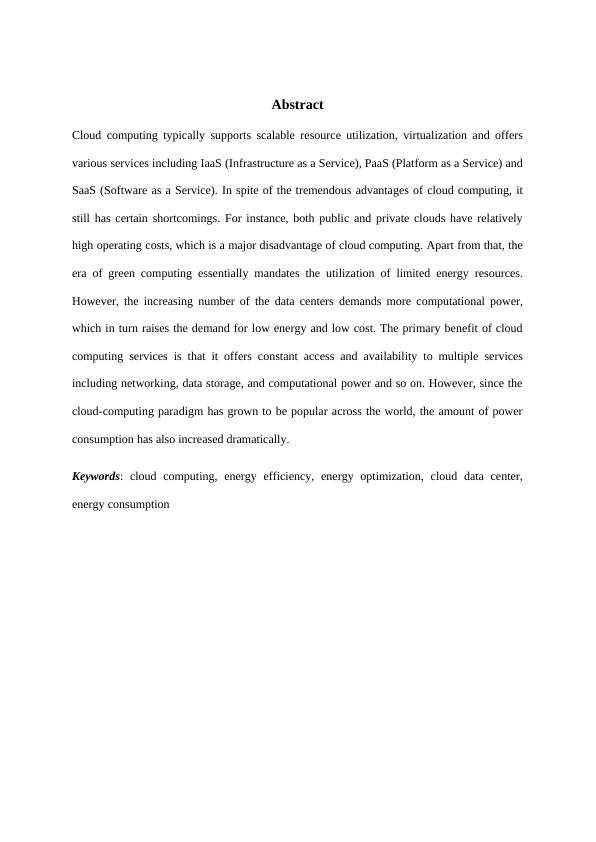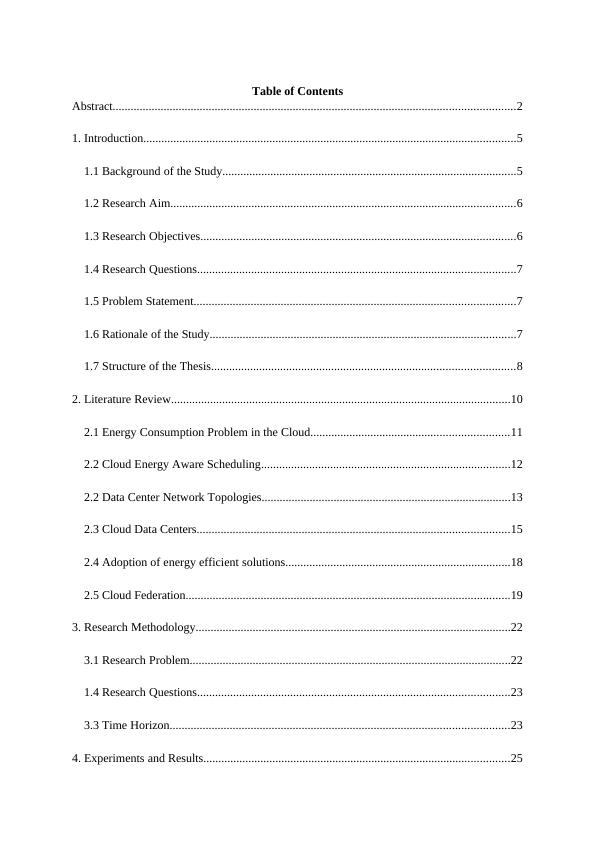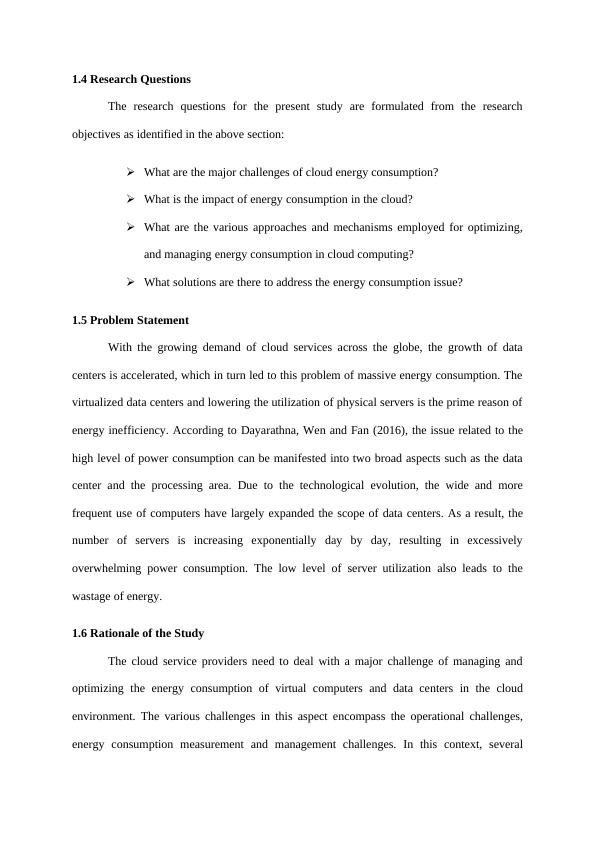Energy Optimization and Management in Cloud Computing
Added on 2022-11-29
41 Pages10590 Words286 Views
Energy Optimization and Management in
Cloud Computing
Full Name
Student ID
Submitted for unit NIT6042 (Thesis 2)
Date
Cloud Computing
Full Name
Student ID
Submitted for unit NIT6042 (Thesis 2)
Date

Abstract
Cloud computing typically supports scalable resource utilization, virtualization and offers
various services including IaaS (Infrastructure as a Service), PaaS (Platform as a Service) and
SaaS (Software as a Service). In spite of the tremendous advantages of cloud computing, it
still has certain shortcomings. For instance, both public and private clouds have relatively
high operating costs, which is a major disadvantage of cloud computing. Apart from that, the
era of green computing essentially mandates the utilization of limited energy resources.
However, the increasing number of the data centers demands more computational power,
which in turn raises the demand for low energy and low cost. The primary benefit of cloud
computing services is that it offers constant access and availability to multiple services
including networking, data storage, and computational power and so on. However, since the
cloud-computing paradigm has grown to be popular across the world, the amount of power
consumption has also increased dramatically.
Keywords: cloud computing, energy efficiency, energy optimization, cloud data center,
energy consumption
Cloud computing typically supports scalable resource utilization, virtualization and offers
various services including IaaS (Infrastructure as a Service), PaaS (Platform as a Service) and
SaaS (Software as a Service). In spite of the tremendous advantages of cloud computing, it
still has certain shortcomings. For instance, both public and private clouds have relatively
high operating costs, which is a major disadvantage of cloud computing. Apart from that, the
era of green computing essentially mandates the utilization of limited energy resources.
However, the increasing number of the data centers demands more computational power,
which in turn raises the demand for low energy and low cost. The primary benefit of cloud
computing services is that it offers constant access and availability to multiple services
including networking, data storage, and computational power and so on. However, since the
cloud-computing paradigm has grown to be popular across the world, the amount of power
consumption has also increased dramatically.
Keywords: cloud computing, energy efficiency, energy optimization, cloud data center,
energy consumption

Table of Contents
Abstract......................................................................................................................................2
1. Introduction............................................................................................................................5
1.1 Background of the Study..................................................................................................5
1.2 Research Aim...................................................................................................................6
1.3 Research Objectives.........................................................................................................6
1.4 Research Questions..........................................................................................................7
1.5 Problem Statement...........................................................................................................7
1.6 Rationale of the Study......................................................................................................7
1.7 Structure of the Thesis.....................................................................................................8
2. Literature Review.................................................................................................................10
2.1 Energy Consumption Problem in the Cloud..................................................................11
2.2 Cloud Energy Aware Scheduling...................................................................................12
2.2 Data Center Network Topologies...................................................................................13
2.3 Cloud Data Centers........................................................................................................15
2.4 Adoption of energy efficient solutions...........................................................................18
2.5 Cloud Federation............................................................................................................19
3. Research Methodology.........................................................................................................22
3.1 Research Problem...........................................................................................................22
1.4 Research Questions........................................................................................................23
3.3 Time Horizon.................................................................................................................23
4. Experiments and Results......................................................................................................25
Abstract......................................................................................................................................2
1. Introduction............................................................................................................................5
1.1 Background of the Study..................................................................................................5
1.2 Research Aim...................................................................................................................6
1.3 Research Objectives.........................................................................................................6
1.4 Research Questions..........................................................................................................7
1.5 Problem Statement...........................................................................................................7
1.6 Rationale of the Study......................................................................................................7
1.7 Structure of the Thesis.....................................................................................................8
2. Literature Review.................................................................................................................10
2.1 Energy Consumption Problem in the Cloud..................................................................11
2.2 Cloud Energy Aware Scheduling...................................................................................12
2.2 Data Center Network Topologies...................................................................................13
2.3 Cloud Data Centers........................................................................................................15
2.4 Adoption of energy efficient solutions...........................................................................18
2.5 Cloud Federation............................................................................................................19
3. Research Methodology.........................................................................................................22
3.1 Research Problem...........................................................................................................22
1.4 Research Questions........................................................................................................23
3.3 Time Horizon.................................................................................................................23
4. Experiments and Results......................................................................................................25

4.1 Presentation of the results..............................................................................................25
4.1.1 The CloudSim Simulator.........................................................................................25
4.1.2 The CloudSim architecture.....................................................................................26
4.1.3 The SoS (System of Systems) functional architecture............................................28
4.2 System Model.................................................................................................................29
4.3 Simulation tool...............................................................................................................29
4.4 Discussion......................................................................................................................32
5. Conclusion............................................................................................................................35
5.1 Limitation of the Study..................................................................................................35
5.5 Further Scope of the Study.............................................................................................36
References................................................................................................................................36
4.1.1 The CloudSim Simulator.........................................................................................25
4.1.2 The CloudSim architecture.....................................................................................26
4.1.3 The SoS (System of Systems) functional architecture............................................28
4.2 System Model.................................................................................................................29
4.3 Simulation tool...............................................................................................................29
4.4 Discussion......................................................................................................................32
5. Conclusion............................................................................................................................35
5.1 Limitation of the Study..................................................................................................35
5.5 Further Scope of the Study.............................................................................................36
References................................................................................................................................36


1. Introduction
The tremendous growth in the technological front, starting from server virtualization
to multi-tenant cloud models, the increasing number of cloud data centers is consuming an
enormous amount of power. Cloud computing essentially solves some serious problem such
as elimination of chronic costs, management of inefficiencies and dismal CPU utilization
levels. Large farms all across the world are rapidly deploying the cloud strategies to get rid of
the burden of maintaining the physical servers (Helleret al., 2015). However, the cramming
number of data centers and virtual machines (VMs) are creating major business data traffic
on the network. As a result, the dramatic increase in power consumption is leading to several
environmental as well as operational problems (higher power costs). In addition to that, there
are huge concerns in terms of the ability of the power grids to support the escalating energy
consumption requirements along with the elastic demand requirements of the cloud
environment.
1.1 Background of the Study
The energy consumption by the cloud data centers increasing at an exponential rate is
becoming a huge challenge for the cloud service providers. The cloud users are no more tied
to the physical infrastructure as their applications, software and data everything is access
through virtual services. Thus, the rapid migration of application platforms onto the cloud
environments is resulting into and increased demand for resources by the data centers. The
severe heat dissipated by the integrated servers and the associated cloud computing
equipment is automatically boosting the emission of harmful gases causing greenhouse effect
and increasing the amount of carbon footprints (Jalaliet al., 2016). In addition to that, the
high degree of power consumption is also responsible of entailing phenomena such as floods,
droughts and abnormal rise in the temperature. However, it is obvious that energy savings
The tremendous growth in the technological front, starting from server virtualization
to multi-tenant cloud models, the increasing number of cloud data centers is consuming an
enormous amount of power. Cloud computing essentially solves some serious problem such
as elimination of chronic costs, management of inefficiencies and dismal CPU utilization
levels. Large farms all across the world are rapidly deploying the cloud strategies to get rid of
the burden of maintaining the physical servers (Helleret al., 2015). However, the cramming
number of data centers and virtual machines (VMs) are creating major business data traffic
on the network. As a result, the dramatic increase in power consumption is leading to several
environmental as well as operational problems (higher power costs). In addition to that, there
are huge concerns in terms of the ability of the power grids to support the escalating energy
consumption requirements along with the elastic demand requirements of the cloud
environment.
1.1 Background of the Study
The energy consumption by the cloud data centers increasing at an exponential rate is
becoming a huge challenge for the cloud service providers. The cloud users are no more tied
to the physical infrastructure as their applications, software and data everything is access
through virtual services. Thus, the rapid migration of application platforms onto the cloud
environments is resulting into and increased demand for resources by the data centers. The
severe heat dissipated by the integrated servers and the associated cloud computing
equipment is automatically boosting the emission of harmful gases causing greenhouse effect
and increasing the amount of carbon footprints (Jalaliet al., 2016). In addition to that, the
high degree of power consumption is also responsible of entailing phenomena such as floods,
droughts and abnormal rise in the temperature. However, it is obvious that energy savings

would compromise the performance of the computing servers. According to Boruet al.
(2015), performance loss due to energy savings is a major and recurrent issue, which needs to
be addressed. In this context, an energy efficient model is required for optimizing and
managing the energy consumption in the cloud environment. There are several existing
studies in this area and the present study aims at unveiling the primary aspects related to the
optimization, conservation and management of could data center energy.
1.2 Research Aim
The study aims to investigate the energy efficient approaches and techniques
deployed in the cloud in order to address the exponential increase in power consumption by
the data centers to manage the enormous amount of data traffic on the Internet. a significant
number of research works have been undertaken in the same area that try to examine the
ways to reduce the amount of power consumption of cloud data center servers. Several works
have addressed the placement of virtual machines (VMP) that majorly concerns with the
performance and energy aspects. Thus, the primary focus of this study is to examine and
study the approaches towards energy optimization and management in cloud computing.
1.3 Research Objectives
The objectives for the present study are formulated below:
To identify the major challenges of cloud energy consumption
To investigate the impact of energy consumption in the cloud
To understand the various approaches and mechanism employed for
optimizing and managing energy consumption in cloud computing
To propose recommendations from secondary sources to address the energy
consumption issue
(2015), performance loss due to energy savings is a major and recurrent issue, which needs to
be addressed. In this context, an energy efficient model is required for optimizing and
managing the energy consumption in the cloud environment. There are several existing
studies in this area and the present study aims at unveiling the primary aspects related to the
optimization, conservation and management of could data center energy.
1.2 Research Aim
The study aims to investigate the energy efficient approaches and techniques
deployed in the cloud in order to address the exponential increase in power consumption by
the data centers to manage the enormous amount of data traffic on the Internet. a significant
number of research works have been undertaken in the same area that try to examine the
ways to reduce the amount of power consumption of cloud data center servers. Several works
have addressed the placement of virtual machines (VMP) that majorly concerns with the
performance and energy aspects. Thus, the primary focus of this study is to examine and
study the approaches towards energy optimization and management in cloud computing.
1.3 Research Objectives
The objectives for the present study are formulated below:
To identify the major challenges of cloud energy consumption
To investigate the impact of energy consumption in the cloud
To understand the various approaches and mechanism employed for
optimizing and managing energy consumption in cloud computing
To propose recommendations from secondary sources to address the energy
consumption issue

1.4 Research Questions
The research questions for the present study are formulated from the research
objectives as identified in the above section:
What are the major challenges of cloud energy consumption?
What is the impact of energy consumption in the cloud?
What are the various approaches and mechanisms employed for optimizing,
and managing energy consumption in cloud computing?
What solutions are there to address the energy consumption issue?
1.5 Problem Statement
With the growing demand of cloud services across the globe, the growth of data
centers is accelerated, which in turn led to this problem of massive energy consumption. The
virtualized data centers and lowering the utilization of physical servers is the prime reason of
energy inefficiency. According to Dayarathna, Wen and Fan (2016), the issue related to the
high level of power consumption can be manifested into two broad aspects such as the data
center and the processing area. Due to the technological evolution, the wide and more
frequent use of computers have largely expanded the scope of data centers. As a result, the
number of servers is increasing exponentially day by day, resulting in excessively
overwhelming power consumption. The low level of server utilization also leads to the
wastage of energy.
1.6 Rationale of the Study
The cloud service providers need to deal with a major challenge of managing and
optimizing the energy consumption of virtual computers and data centers in the cloud
environment. The various challenges in this aspect encompass the operational challenges,
energy consumption measurement and management challenges. In this context, several
The research questions for the present study are formulated from the research
objectives as identified in the above section:
What are the major challenges of cloud energy consumption?
What is the impact of energy consumption in the cloud?
What are the various approaches and mechanisms employed for optimizing,
and managing energy consumption in cloud computing?
What solutions are there to address the energy consumption issue?
1.5 Problem Statement
With the growing demand of cloud services across the globe, the growth of data
centers is accelerated, which in turn led to this problem of massive energy consumption. The
virtualized data centers and lowering the utilization of physical servers is the prime reason of
energy inefficiency. According to Dayarathna, Wen and Fan (2016), the issue related to the
high level of power consumption can be manifested into two broad aspects such as the data
center and the processing area. Due to the technological evolution, the wide and more
frequent use of computers have largely expanded the scope of data centers. As a result, the
number of servers is increasing exponentially day by day, resulting in excessively
overwhelming power consumption. The low level of server utilization also leads to the
wastage of energy.
1.6 Rationale of the Study
The cloud service providers need to deal with a major challenge of managing and
optimizing the energy consumption of virtual computers and data centers in the cloud
environment. The various challenges in this aspect encompass the operational challenges,
energy consumption measurement and management challenges. In this context, several

End of preview
Want to access all the pages? Upload your documents or become a member.
Related Documents
Energy Optimization and Management in Cloud Computinglg...
|35
|2571
|113
Annotated Bibliography on Energy Efficiency in Cloud Computinglg...
|11
|3345
|437
Optimal Optimization Based On CLOUD COMPUTING ASSIGNMENT -3lg...
|32
|8368
|223
Issues and Opportunities in Cloud Computing: A Research Perspectivelg...
|9
|782
|334
Data Centres Uses and benefitslg...
|2
|578
|116
Virtualization Assessment 2022lg...
|7
|1962
|19
